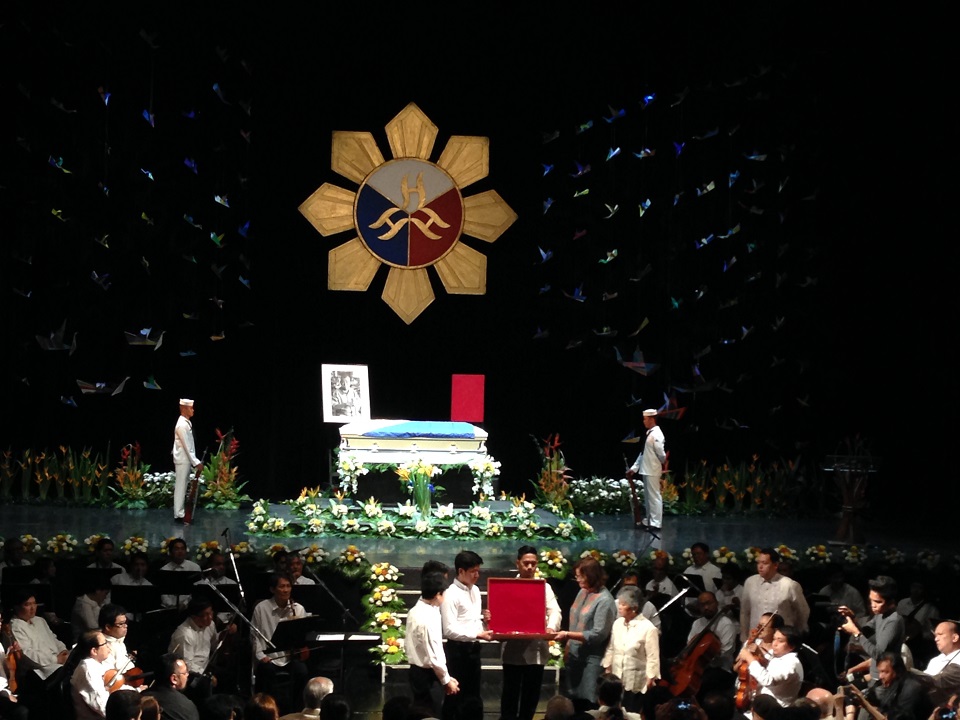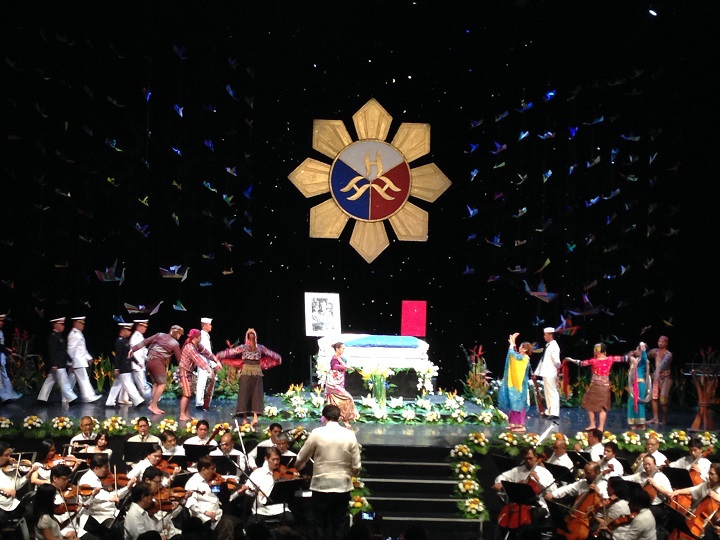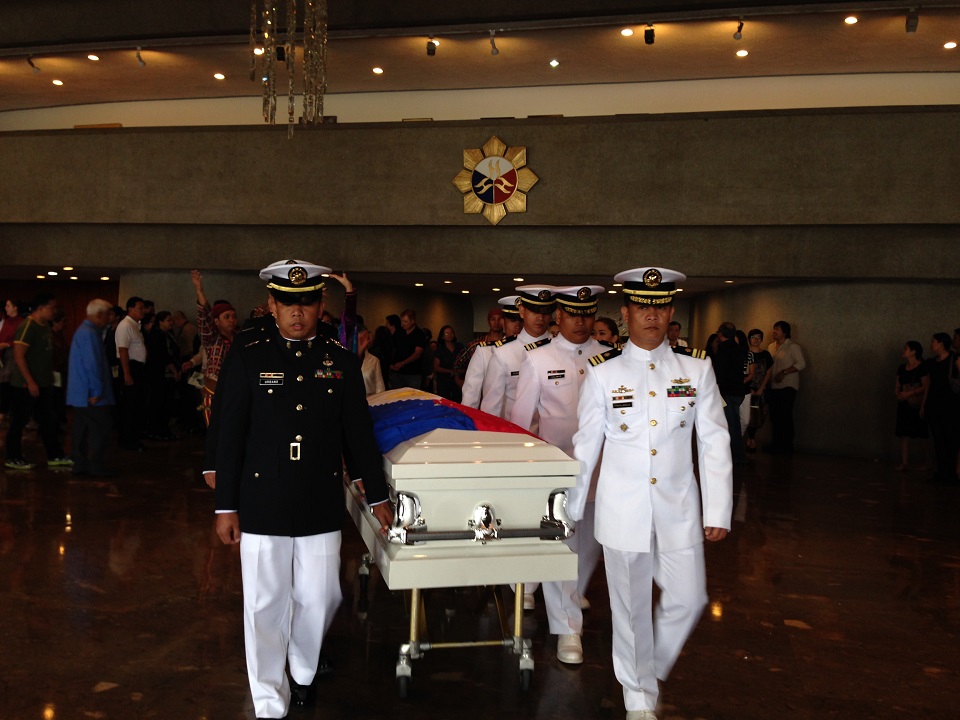Filtered By: Lifestyle
Lifestyle
State necrological service for National Artist Abdulmari Imao held at CCP
Text and photos by IBARRA C. MATEO

Officials of the Cultural Center of the Philippines and the National Commission for Culture and the Arts symbolically turn over Abdulmari Asia Imao's National Artist Medallion to his grandchildren during the traditional state necrological service for the artist at the CCP's Tanghalang Nicanor Aberlado on Sunday, Dec. 21, 2014. Imao, the first Filipino-Muslim national artist, died on Dec. 16. He would have turned 79 on Jan. 14.
Imao, who died on December 16, would have turned 79 on January 14.
Then-President Gloria M. Arroyo conferred the title of National Artist for Visual Arts on Imao on June 9, 2006, calling him “an articulator of Philippine Muslim art and culture” and “a versatile and prolific Muslim-Filipino artist.”
After the understatedly elegant but colorful rites, marked by Muslim accents and performances at the Tanghalang Nicanor Abelardo, Imao was interred at the Libingan ng mga Bayani at noon.
First Muslim National Artist
During the “Pagdadalamhati ng Bayan” at CCP, Imao’s eldest son Toym de Leon Imao said his father was "a messenger of change."
“His recognition as the first Moro national artist acknowledges not only his body of work, but also the idea that art is a significant and necessary component in the quest to bring understanding and lasting peace with our Muslim brothers and sisters,” Toym said.
“What my father has set out to accomplish, we—his family, my brothers, grandchildren, and many artists from Mindanao whom he had profoundly inspired—hope to achieve. My father’s visual journey about a land that is blessed in diversity and richness like the colors of the rainbow, like the wings of the sarimanok, will continue,” he added.
Among those who delivered eulogies was Sen. Grace Poe, a family friend of the Imaos and a collector of the paintings by the late national artist.
“The walls of my house are adorned with paintings by Mr. Imao. It brings so much joy and happiness to my children whenever they look at the colorful creations of Mr. Imao,” she said.
“When my mother-in-law found out that I would be speaking here today, she requested me to acknowledge the great contributions made by the wife of Mr. Imao, Grace, in raising their children, nurturing their family, and in his successes and achievements as an artist, sculptor, painter, photographer, ceramist, documentary film-maker, cultural researcher and writer,” Poe added.
The senator also said that now that Imao “is in heaven, we have an advocate for the Bangsamoro law up there.”
Courage

The Ramon Obusan Folkloric Group performs a Muslim dance number during the service.
“Imao had courage. He took a boat, leaving the poor Siasi municipality to pursue studies in Manila, without knowing anybody in the city. He excelled in his artistic pursuits, showing his love for the arts despite the challenges. All this is courage,” Ansaldo told the crowd.
Ansaldo said his family decided to “adopt” the young Imao, supporting him until he finished his studies at the UP College of Fine Arts. “He became a family member. He was one of us.”
Using Allah's gift
The hundreds of sarimanok hanging overhead in the CCP Main Theater were crafted by Imao himself, part of an installation he was working on before he died.
According to CCP Chairman Emily Abrera, Imao drew his inspiration from Tausug and Maranao artistic traditions, particularly the art of the okir wood-carving design.
“His art evolved into four distinct but inter-related themes: Islamic calligraphy, the sari-mosque—a design combining the sarimanok and the form of the mosque—the sari-okir, and the famous Filipino mythical bird with fish called sarimanok, which earned him the name Mr. Sarimanok,” Abrera said.
National Commission for Culture and the Arts officer-in-charge and director Adelina M. Suemith said that due to Imao’s use of the sarimanok, it “has been iconized and indigenized as a symbol of the Filipino people.”
“He not only molded the implements on which he created his masterpieces; Dr. Imao shaped the future of Muslim and Filipino art through his innovations. His contributions have enriched our national art scene and have helped in developing the brass-casting technologies of Asian countries like Sri Lanka, Thailand, and Indonesia,” Suemith said.
In an audio-visual presentation featuring Imao being interviewed, the national artist said he was often asked why a Muslim like him did figurative works.
He replied, “Allah gave me this wonderful talent, as well as skilled hands and an independent mind to create beautiful things. Everything that comes from Allah is good. I think I would disappoint Allah if I did not use my God-given talent at all.”
Tributes

After the service, honor guards escort Imao's remains out of the CCP Main Lobby to a waiting hearse.
The program included performances by singer Joey Ayala, the De La Salle University Dasmariñas Chorale, and by the Ramon Obusan Folkloric Group.
Imao was cited for his “sculptures of diverse mediums and styles, as well as his refined and innovative rendering of indigenous art images and motifs” which were “testimonies of his highly developed aesthetic sensibility, ingenuity, and wide-ranging experience as an artist.”
His major works included the Antonio Pigafetta Monument in Fort San Pedro, Cebu City; the President Elpidio Quirino Monument in Roxas Boulevard; the Amandagat Monument in Batanes; and the Sultan Kadarat Mural in the Philippine International Convention Center (PICC). — BM, GMA News
More Videos
Most Popular



